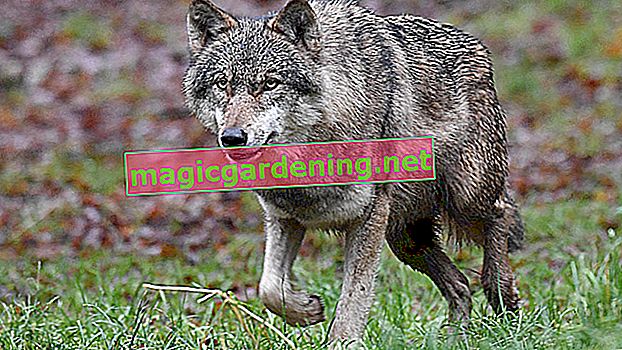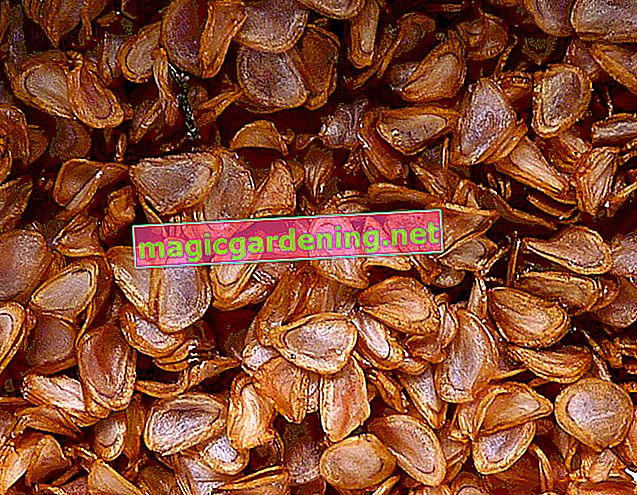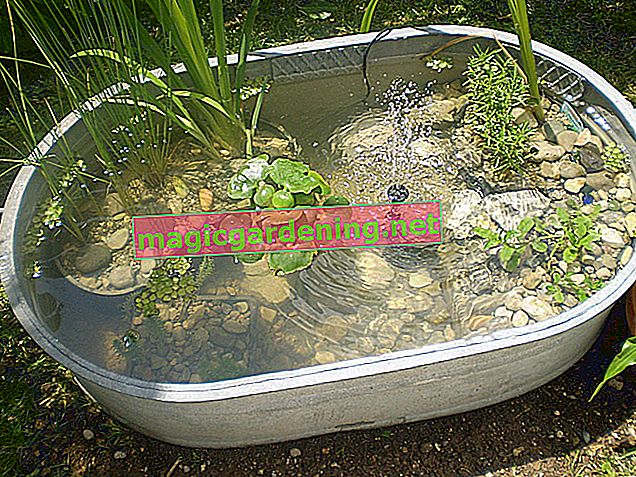
origin
The fat man has many names. It is called Dickanthere because of its conspicuous stamens, and it was named Shadow Green because of its location requirements. The scientific name Pachysandra terminalis provides information about the genus. Ysander species are box trees. The fat man, known to botanists as the Japanese Ysander, grows in the humid forests of China and Japan.
also read
- Plant fat men or ysander correctly
- The best time to plant for fat men or ysander
- That is how easy it is to multiply fat men
growth
The shade green is a semi-woody shrub whose shoots grow upright or crawl across the ground. This evergreen subshrub grows between 15 and 30 centimeters high. Its branches form a thick bush. The perennial plant forms subterranean rhizomes that serve as energy stores and an organ of distribution. The tubers form runners that run through the substrate. In this way, fat males develop an area-covering growth.
leaves
Pachysandra terminalis develops deciduous leaves that are divided into a leaf blade and a stalk. The simple leaf blade is only slightly notched at the tip. It grows between six and ten centimeters long and is lanceolate in shape.
The leaves are arranged alternately or crowd in groups of four or six in small groups that sit on short shoots that are lignified at the base. Your blade appears leathery, thickened and coarse. They serve as water reservoirs and remain on the plant even in winter. They adorn the garden with lush green tones all year round. If the location is too sunny, the leaves turn yellow.
blossom
As a monoecious plant, the Japanese Ysander develops unisexual flowers. Male and female flowers crowd together in a spike-like inflorescence. This becomes between two and four centimeters long and grows upright in height. It sits at the end of the shoot and is supported by bracts.
The flowers of the fat man are inconspicuous. The male flowers consist of four white to greenish colored bracts and the same number of stamens, which appear strikingly thick. The female counterpart consists of four to six light green bracts and an ovary that ends in two to three styles. Many varieties have lost their ability to reproduce through breeding. They develop sterile flowers that cannot produce fruit.
Particularities:
- partially blooms from February to May
- candle-shaped inflorescences
- Inflorescence with more than 15 male flowers
- one or two female flowers sit below the male flowers
fruit
After the flowers have wilted, small and inconspicuous stone fruits with a white outer skin develop on the inflorescences. They are five to six millimeters long, egg-shaped and contain two to three black colored seeds. The style remains until the fruit is fully ripe.
use
Shade green is a popular ornamental plant for underplanting trees. The fat man thrives in these shady and damp places. It is also planted in slightly sunny open spaces. In many gardens and parks, the plant is not combined with other plants, but is planted as a single variety. In this way, uniform and area-covering carpets with dense foliage are created, which exude a harmonious character. These carpets adorn the subsurface of taller shrubs.
The Japanese ysander is used as a grave plant and as a leaf ornament, whose densely leafy shoots decorate bouquets. Dickmännchen are also decorative flower plants that highlight themed gardens in spring. They provide color accents in forest gardens, formal bed arrangements and in the rhododendron garden.
Perfect neighbors:
- Spanish rabbit bell
- Larkspur
- Grape heather
- Japanese holly
Ground cover
Because of its ability to grow and spread, the fat man is often planted as a ground cover. Within a very short time it plants fallow areas and hides unsightly spots in the garden. The plants have earned the nickname “leaf swallowers”, as fallen leaves are quickly decomposed on the ground.
Is fat man poisonous?
The fat man develops steroid alkaloids, which are concentrated to different degrees in the different parts of the plant. Serious symptoms of poisoning only occur after consuming large quantities. You should still be careful that your pets do not nibble on the leaves or children accidentally taste parts of plants.
Continue reading
Which location is suitable?
Shadow green grows in partial shade and thrives splendidly in dark corners of the garden. The plants have adapted to the lack of light and can also photosynthesize in shady locations. A sunny location causes problems for the semi-shrubs. They don't mind root pressure. The plants are suitable for the urban climate.
What soil does the plant need?
Pachysandra terminalis likes well-loosened soil with medium permeability. The substrate may be humus and should ensure fresh to moderately moist conditions. Dry conditions damage vitality. Fat males can only tolerate small amounts of lime in the soil. They grow on substrates with a pH between 6.5 and 7.5. The plants tolerate a weakly acidic environment.
What is the best time to plant?
Shade green can be planted in the garden all year round, as young plants that have been brought forward are continuously offered in containers. Planting is also possible in winter as long as the ground is not frozen.
Plant spacing
So that fat men form a dense carpet as quickly as possible, you should plant seven to twelve plants per square meter. Make sure that there is a distance of 20 to 30 centimeters between the young plants so that they can take root and expand freely in width.
How to plant fat men:
- The planting hole should be deeper than the height of the root ball
- Insert the plant with the substrate
- Fill gaps with excavated material
- Press the substrate lightly
- irrigate thoroughly
Multiplication
In spring and autumn, dense stands can be divided as the plants develop underground runners. To do this, you do not have to dig out the entire root ball but only part of it. Use a sharp knife to cut off a root runners that have already developed fine roots. Make sure that as few roots as possible tear off the runners when pulling out. Plant the root piece in the desired location and keep the substrate well moist. Fill the dug hole with soil.
Continue reading
sowing
Seed sowing is possible if your plant produces fruit. Since this method of propagation does not produce true offspring, fat males are preferably propagated using cuttings and runners. Seeds are rarely offered in stores. Exchange sites are a good place to go to get seeds of special strains.
Cuttings
Between May and June you can reproduce fat males using head cuttings. The shoots should not be lignified yet, as hardened branches have very poor roots. Cut cuttings about seven centimeters long from a vital and strong mother plant and remove the lowest leaves.
Dickmaennchen in the pot
Ground cover like the fat man also cuts a fine figure in the bucket. Choose the largest possible planter and use one plant per pot. The densely growing shrubs create a splendid picture in the planter, which is particularly suitable for shady balconies or north-facing house entrances.
Watering fat men
The water requirement of the plants is moderate. Thanks to the dense foliage, the plants protect the substrate from drying out. A humid microclimate develops under the canopy, from which not only the subshrubs but also the organisms benefit. Since fat men prefer to grow in shady locations, there is little risk of drying out in both summer and winter. You should also water the plants in particularly hot months, when periods free of precipitation last for a long period of time.
Fertilize fat men properly
Shade green hardly needs any nutrients to grow. Young plants are placed in a humus-rich substrate to support them in their growth phase. In autumn of the first year you can also treat the young plants to some compost. From the second year onwards, the plants are no longer fertilized.
Continue reading
Properly cut fat men
The Japanese Ysander delights every hobby gardener with undemanding care. Young plants can be pruned regularly so that they form dense branches and grow bushier. No regular pruning measures are necessary in the further course of growth. If necessary, you can loosen up stands that have become too dense, shorten plants that have grown too high or prune back loosely growing specimens.
The ideal time to prune is after flowering between April and May. Bare shoots can be cut just above the ground all year round. If the plant forms runners in an uncontrolled manner, which sprout outside the stand, these can be uprooted.
Continue reading
Hardy
Although the plants are evergreen, they are unimpressed by frosty temperatures. Fat men are hardy and can withstand temperatures down to -28 ° Celsius. Additional protection is not necessary. The dense foliage protects the soil from temperature fluctuations. If the plants grow under trees, the falling leaves cover the ground between the fat men. This creates a natural layer of mulch.
How do I transplant properly?
If the subshrubs need to be moved, you can easily dig up and transplant the individual plants. Be careful not to damage the roots as much as possible. The older the plant, the more fine roots permeate the substrate. Since fine roots are always lost with this measure, the plant has to regenerate again after it has been moved. Therefore, you should think about propagating with the help of the root runners. It is possible without any problems and at the same time rejuvenates the population.
Diseases
Fat males often suffer from chlorosis, which is also known as yellow or bleaching. This deficiency symptom indicates that the chlorophyll content is too low. The dye makes the leaves appear green and is essential for photosynthesis. If there is a lack of chlorophyll, the leaves can no longer use solar energy.
Symptoms
Affected plants develop yellow leaves that wither and die as the disease progresses. The plant sheds leaves and flowers and stops growing. The reasons for this disease are many. In the fat man, calcareous soil causes chlorosis. The plants cannot absorb iron in a substrate with too high a pH value, so that a deficiency symptom arises.
prevention
If you notice chlorosis in your plant, consider improving the substrate with rhododendron soil. Alternatively, you can cover the soil with needle litter. The needles are broken down by the soil organisms and the acid concentration of the soil increases.
How to help your plant:
- ensure optimal site conditions
- do without fertilizers
- Fight pests
- remove diseased shoots and leaves
Continue reading
Fungal attack
The microclimate between the fat men also offers mushrooms optimal growth conditions. Certain factors also favor a fungal attack. Affected plants should be dug up and completely freed from the old substrate. Cut off affected parts of the plant and move the fat man to a new location.
Volutella
The fungal spores of the species Volutella pachysandrae survive in the substrate for a long time, so that they can infect cuttings and young plants at any time. Infested plants show typical damage patterns. Their leaves develop brownish spots with concentric rings that can be round or oval. If the disease is more advanced, brown discoloration occurs at the base of the stem. The shoots gradually die off.
Heavily infested plants should be dug out of the ground and disposed of. Also, remove the surrounding soil to get rid of as many spores as possible. As soon as you see the first signs on the leaves, use fungicides as a preventive measure.
Phytopphthora
This fungus is responsible for root rot. Its spores settle on already rotten roots and penetrate the organism. The plant is visibly weakened. She loses leaves and flowers. If left untreated, the plant dies. Since there are no approved fungicides in Germany, you should take preventive measures. The fungal spores feel particularly comfortable in the wet substrate. Make sure that no waterlogging forms.
Yellow leaves
Discoloration of the leaves is not only caused by deficiency symptoms, but also due to incorrect site conditions. If the plants get too much sunlight, the dye chlorophyll is broken down. Other dyes appear which make the leaf appear yellow. This form of chlorosis is equally harmful to the plant because its photosynthetic metabolism no longer works.
As a treatment measure, it is recommended to transplant to a shady location. Here the plants recover quickly. The yellow colored leaves no longer turn green because the plants do not regenerate the dye. They fall off and are replaced by fresh leaves that glow green in the shade.
Tips
There are plants that are very similar to the fat man. The three-leaved Waldsteinie or the small periwinkle are also suitable for greening areas under trees. Plant several specimens of a species alternately in small groups to create a colorful patchwork quilt. This arrangement of plants will put you in a good mood.
sorts
- Green Carpet : Small, narrow leaves. Low and compact growth. Grows to 15 centimeters high.
- Variegata : Grows more slowly, less willing to spread. Leaves with irregular whitish to yellow margins, fine, pale veins.
- Compacta : low growth. Flowers smell of lilac. Height between ten and 15 centimeters.
- Silver Edge : Slow growth, suitable for balcony boxes. Colorful foliage. Up to 20 centimeters high.







